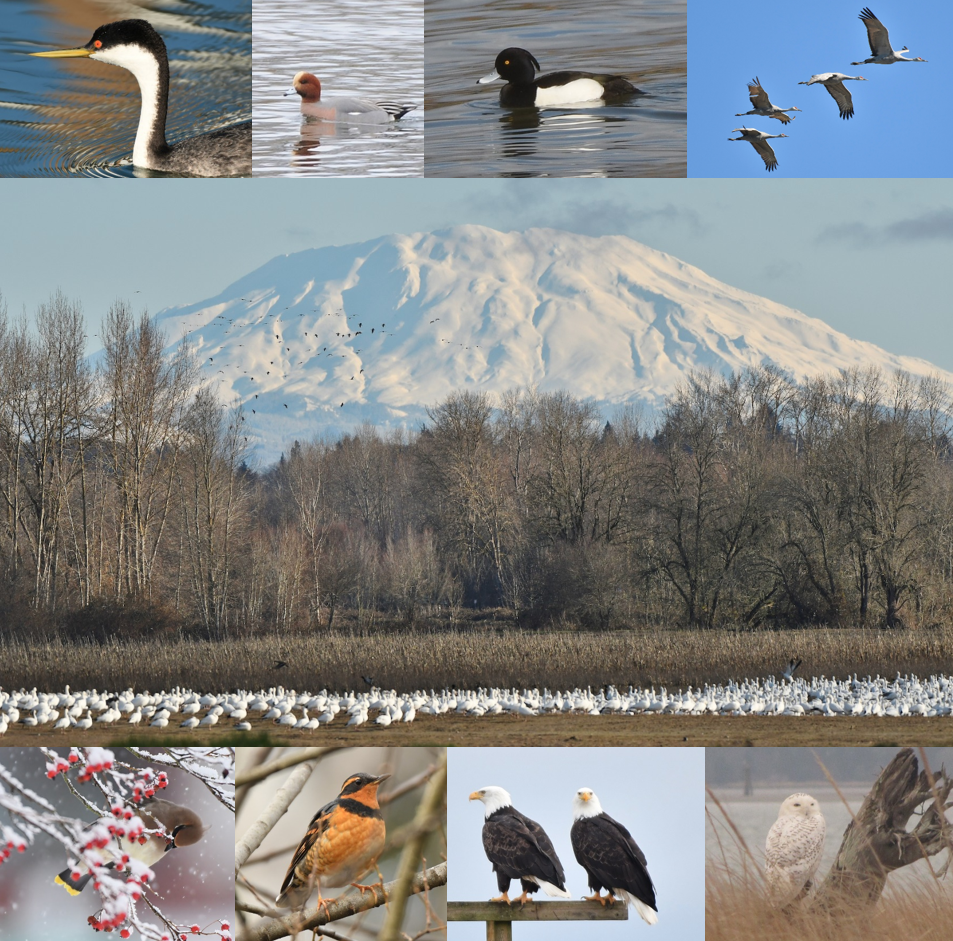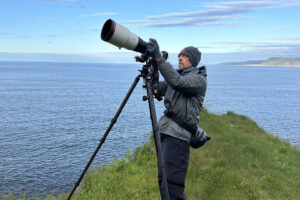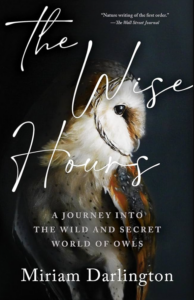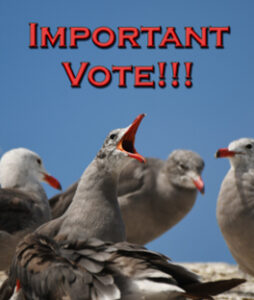
The Many Joys of Winter Birding
By Rachel Hudson
It is rare for me to encounter birders locally who truly enjoy birding at this time of year. I can’t blame them; the rain is relentless, floods are frequent, snow and ice make leaving one’s home hazardous, the high winds turn any precipitation into painful projectiles, and so many of the bright, colorful, energetic little songbirds are long gone. Many birds that remain can be harder to spot, as they are often much quieter and more hunkered down to take shelter in light of the aforementioned winter weather.
However, not all is lost. My second favorite season of the year is winter, with the winter birding opportunities being unique and, to me, flat-out stunning. It is this time of year that the larger birds tend to take the spotlight as they spend the cold, dreary days here among us rather than in the tundra, where many of them breed. Raptors are suddenly much easier to spot, and the flocks of waterbirds that they hunt can contain plenty of beautiful surprises. When snow is on the ground, any passerine in the area will stand out dramatically against its sparkling white backdrop as it searches for any exposed food.
I greatly enjoy seeking out any of the various waterbirds (or water-adjacent birds) in winter. Combing through flocks of thousands of American Wigeon just to find a nice Eurasian Wigeon drake is a favored pastime of mine, which makes sense when I think of all the I Spy and Where’s Waldo books that I perused daily as a child and still have fun looking through to this day. Visiting any body of water, especially flooded fields and marinas…oh! What wonder those places hold.
At local seasonal ponds, mixed flocks of ducks, geese, swans, and more coat the grassy waters, and the sounds of all those little bills dabbling and grazing and smacking never fail to make me grin. Flocks of wigeon, Northern Pintail, Green-winged Teal, Northern Shoveler, Mallard, Ring-necked Duck, Bufflehead, and more can completely cover an area. In amongst them can be a few rare or uncommon things, such as Tufted Duck or Ruddy Duck. On coastlines, the flocks gain their saltwater companions, including scoters, goldeneyes, and scaup. Rarely, other sea ducks such as eiders can join them, making for a memorable winter outing, indeed!
At marinas, resident waterbirds become very accustomed to people, thus they make for unparalleled photo subjects, as well as excellent subjects to study overall. I often visit marinas, and the multitudes of grebes I find there (mostly Western and Horned, with the occasional Red-necked and Pied-billed) are a delight to watch as they dive right below me on the docks, sometimes resurfacing with a tasty little fish a few feet away. The grebes are so quiet and unobtrusive that they can easily go unnoticed, especially when there are flocks of gulls, cormorants, sea ducks, and wintering shorebirds to admire!
Another favored winter delight of mine is going out to see flocks of Sandhill Cranes, along with all the geese and swans I could ever want. The Vancouver Lowlands (if you time it right to avoid heavy hunting days) hold vast multitudes of these birds, and their calls are haunting, awe-inspiring, and strangely thrilling. I will never forget the sounds of hundreds of each of those species calling out to each other as they flew overhead in dense morning fog one day while I was there; an entire world, unseen, wild, yet so close. The cranes’ voices have touched me, ever since I first heard them on a nature show as a child, and getting the chance to see them every year here has been an exceptional treat. Watching them land, as well, as though they wear parachutes, is always a thrill. And the geese! So many thousands of them, mostly Cackling, Canada, and Snow, with their sweet faces, elegant bodies, perfect plumage, and sheer numbers… Wow! Seeing (and hearing) a flock of 10,000+ geese take off from a very short distance away is an experience I believe everyone should have at least once.
Mixed passerines become frequent at home bird feeders, and winter thrushes seem to spring up from every bend in some forest trails and roads. The Varied Thrush, a rather handsome yet strangely frightening bird, can silently materialize from the leaf litter as though it were a phantom, and when it does make itself heard, its eerie ringing whistle can spark a sudden feeling that one is not alone when walking a trail. Hermit Thrushes will also often appear so silently at forest edges, creeping about the earth as they hunt. Gone is the clamoring of all the summer forest bird…now, the cold, dark, dripping trees belong to the thrushes. Meanwhile, in grassy forest edges and small fields or yards, American Robins appear en masse, and they differ from their spooky forest cousins in that they are loud, rambunctious, and everywhere. There’s nothing quite like the spectacle of a winter berry tree covered in robins, with the occasional Cedar Waxwing flock for good measure.
Birds of prey are suddenly far more noticeable in the barren landscape, and scanning the horizon can often yield something interesting perched atop a snag or fence post. Beautiful Rough-legged Hawks can make an appearance, as well as the standard Red-tails and Northern Harriers. Bald Eagles scare up duck flocks at almost every flyby (causing much torment not just to the ducks, but also to the birders who have now lost their chance at finding something really cool in that flock). Also, at this time of year, owls will often make their presence known. The calls of several species of owl, including Great Horned, Pygmy, and Saw-whet, can be heard echoing through the dark nighttime forests, and Short-eared Owls suddenly arrive to hunt in yellowed fields, competing with the Harriers. Even Snowy Owls can rarely appear as they irrupt farther south during population booms.
As I sit here and listen to the heavy rainwater falling off my roof, suddenly, the cold and the wet don’t seem all that bad. I personally love the snow, and I believe it’s certainly worth it, braving the elements to experience all those amazing winter birds…many more species than I can describe here. Then again, I do seem to have the ability to forget any particular torment I have endured if it led to a positive experience in the end. Standing in one spot for ages in frigid snow, brutal wind, or drenching rain to see American Robins or Cedar Waxwings alight on one particular tree, or to find that Eurasian Wigeon, or to hear those Sandhill Cranes… yes, it’s still worth it. I refuse to miss out on the magic and wonder of this world, and I will always hold dear the many joys of winter birding.
Photo credit: All photos by Rachel Hudson. Top, left to right: Western Grebe, Eurasian Wigeon, Tufted Duck, Sandhill Cranes. Center: Mount St. Helens with Snow Geese in the foreground. Bottom, left to right: Cedar Waxwing, Varied Thrush, Bald Eagles, Snowy Owl.







